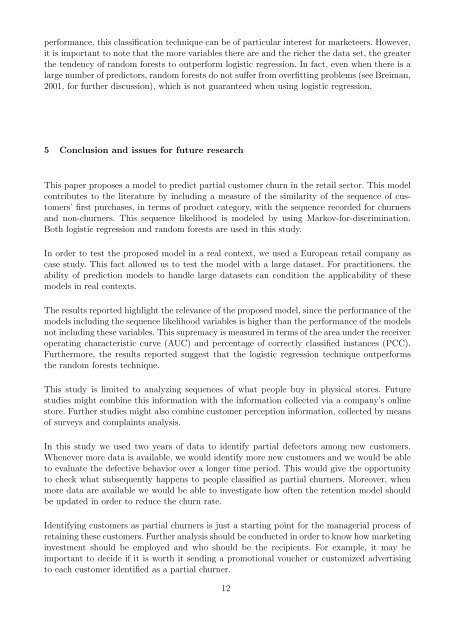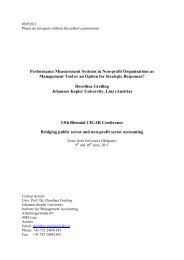Predicting Partial Customer Churn Using Markov for Discrimination ...
Predicting Partial Customer Churn Using Markov for Discrimination ...
Predicting Partial Customer Churn Using Markov for Discrimination ...
You also want an ePaper? Increase the reach of your titles
YUMPU automatically turns print PDFs into web optimized ePapers that Google loves.
per<strong>for</strong>mance, this classification technique can be of particular interest <strong>for</strong> marketeers. However,<br />
it is important to note that the more variables there are and the richer the data set, the greater<br />
the tendency of random <strong>for</strong>ests to outper<strong>for</strong>m logistic regression. In fact, even when there is a<br />
large number of predictors, random <strong>for</strong>ests do not suffer from overfitting problems (see Breiman,<br />
2001, <strong>for</strong> further discussion), which is not guaranteed when using logistic regression.<br />
5 Conclusion and issues <strong>for</strong> future research<br />
This paper proposes a model to predict partial customer churn in the retail sector. This model<br />
contributes to the literature by including a measure of the similarity of the sequence of customers’<br />
first purchases, in terms of product category, with the sequence recorded <strong>for</strong> churners<br />
and non-churners. This sequence likelihood is modeled by using <strong>Markov</strong>-<strong>for</strong>-discrimination.<br />
Both logistic regression and random <strong>for</strong>ests are used in this study.<br />
In order to test the proposed model in a real context, we used a European retail company as<br />
case study. This fact allowed us to test the model with a large dataset. For practitioners, the<br />
ability of prediction models to handle large datasets can condition the applicability of these<br />
models in real contexts.<br />
The results reported highlight the relevance of the proposed model, since the per<strong>for</strong>mance of the<br />
models including the sequence likelihood variables is higher than the per<strong>for</strong>mance of the models<br />
not including these variables. This supremacy is measured in terms of the area under the receiver<br />
operating characteristic curve (AUC) and percentage of correctly classified instances (PCC).<br />
Furthermore, the results reported suggest that the logistic regression technique outper<strong>for</strong>ms<br />
the random <strong>for</strong>ests technique.<br />
This study is limited to analyzing sequences of what people buy in physical stores. Future<br />
studies might combine this in<strong>for</strong>mation with the in<strong>for</strong>mation collected via a company’s online<br />
store. Further studies might also combine customer perception in<strong>for</strong>mation, collected by means<br />
of surveys and complaints analysis.<br />
In this study we used two years of data to identify partial defectors among new customers.<br />
Whenever more data is available, we would identify more new customers and we would be able<br />
to evaluate the defective behavior over a longer time period. This would give the opportunity<br />
to check what subsequently happens to people classified as partial churners. Moreover, when<br />
more data are available we would be able to investigate how often the retention model should<br />
be updated in order to reduce the churn rate.<br />
Identifying customers as partial churners is just a starting point <strong>for</strong> the managerial process of<br />
retaining these customers. Further analysis should be conducted in order to know how marketing<br />
investment should be employed and who should be the recipients. For example, it may be<br />
important to decide if it is worth it sending a promotional voucher or customized advertising<br />
to each customer identified as a partial churner.<br />
12
















